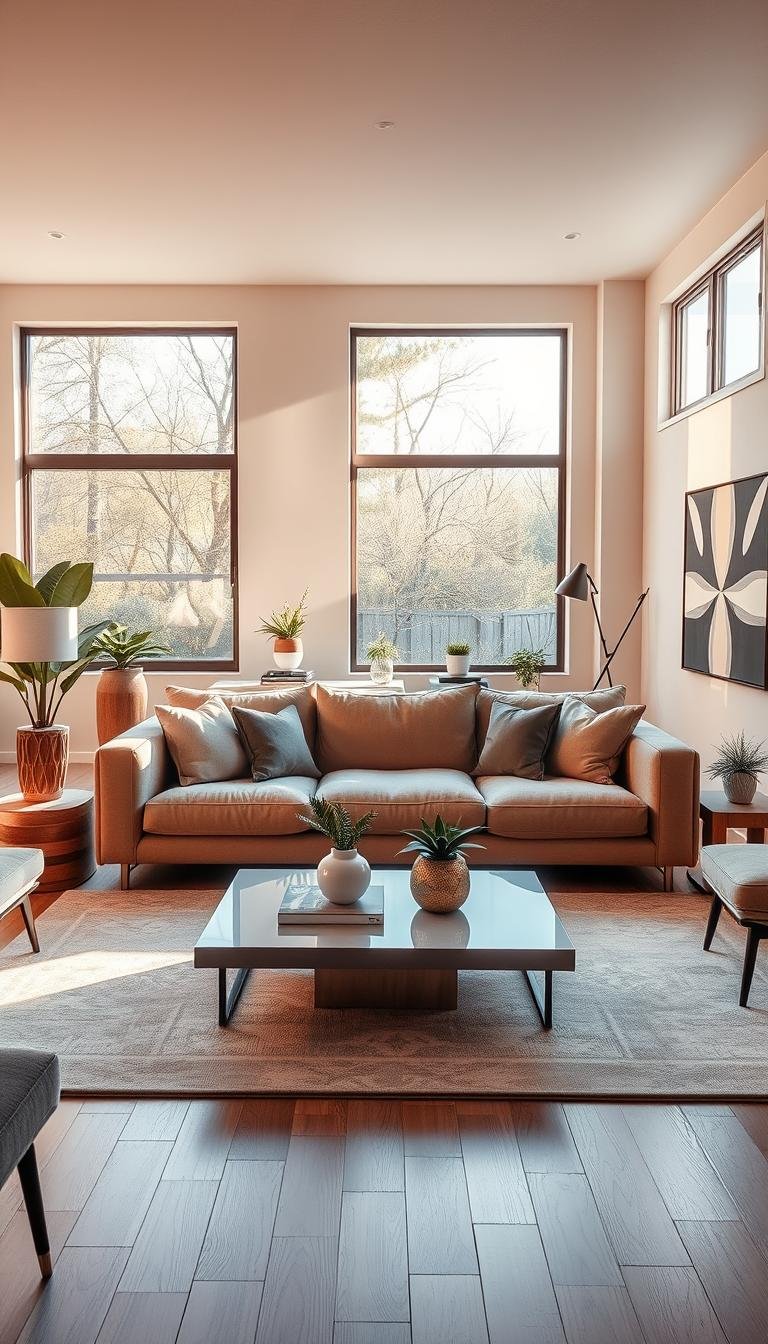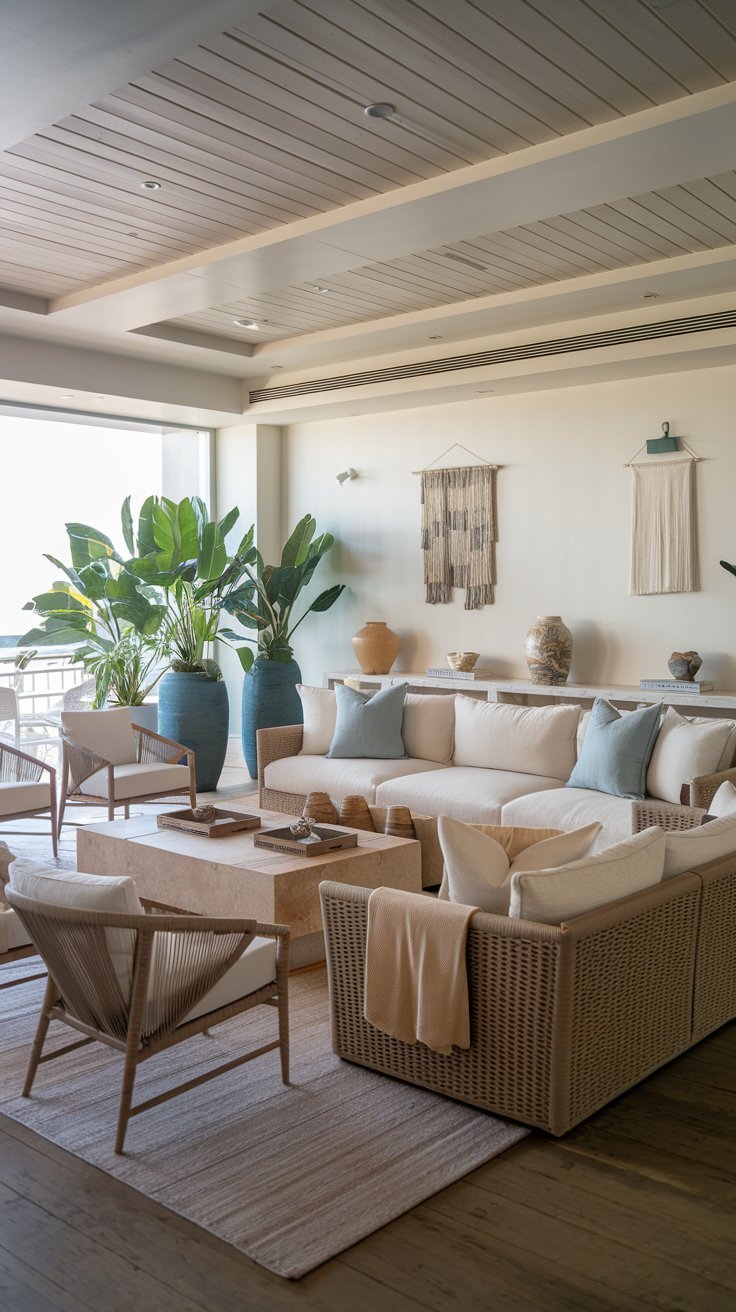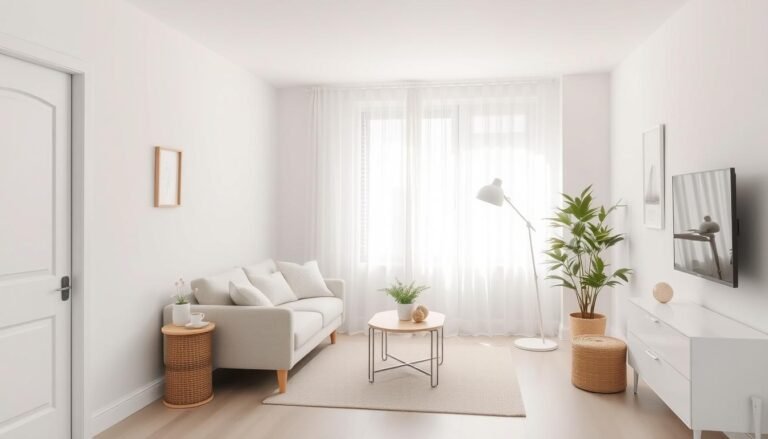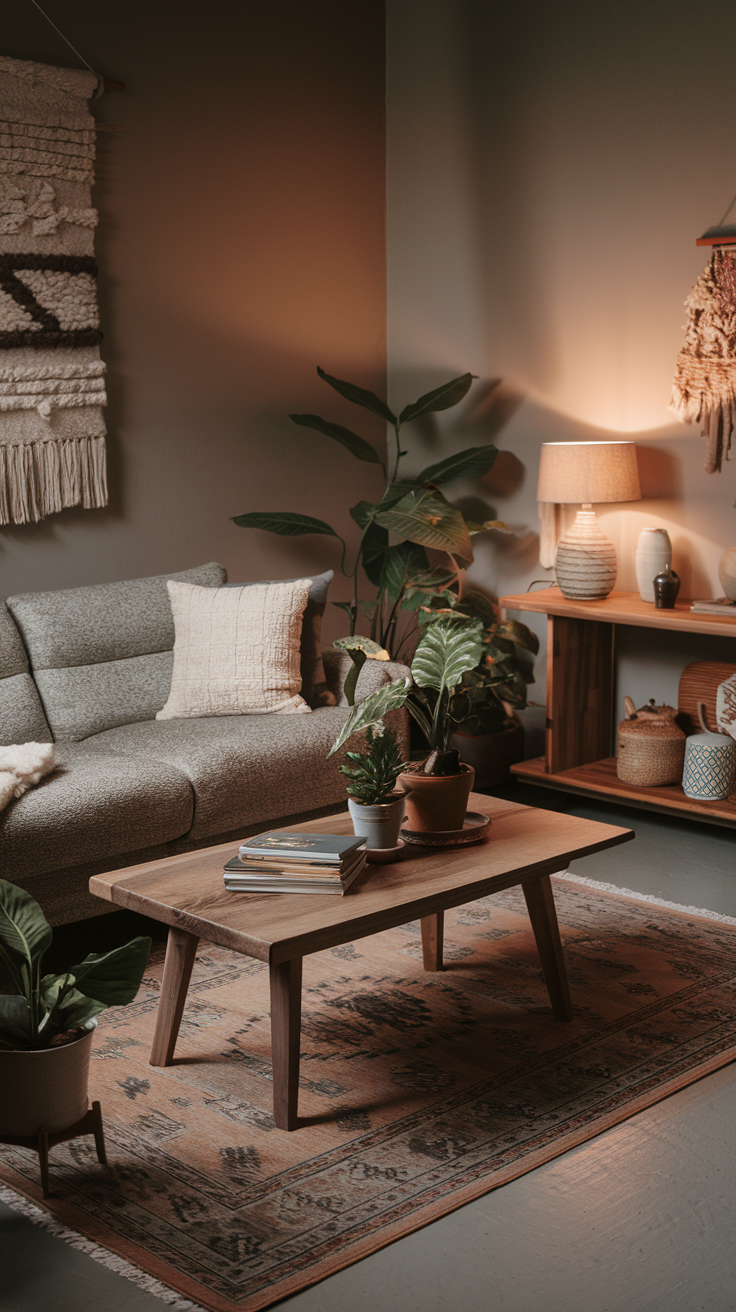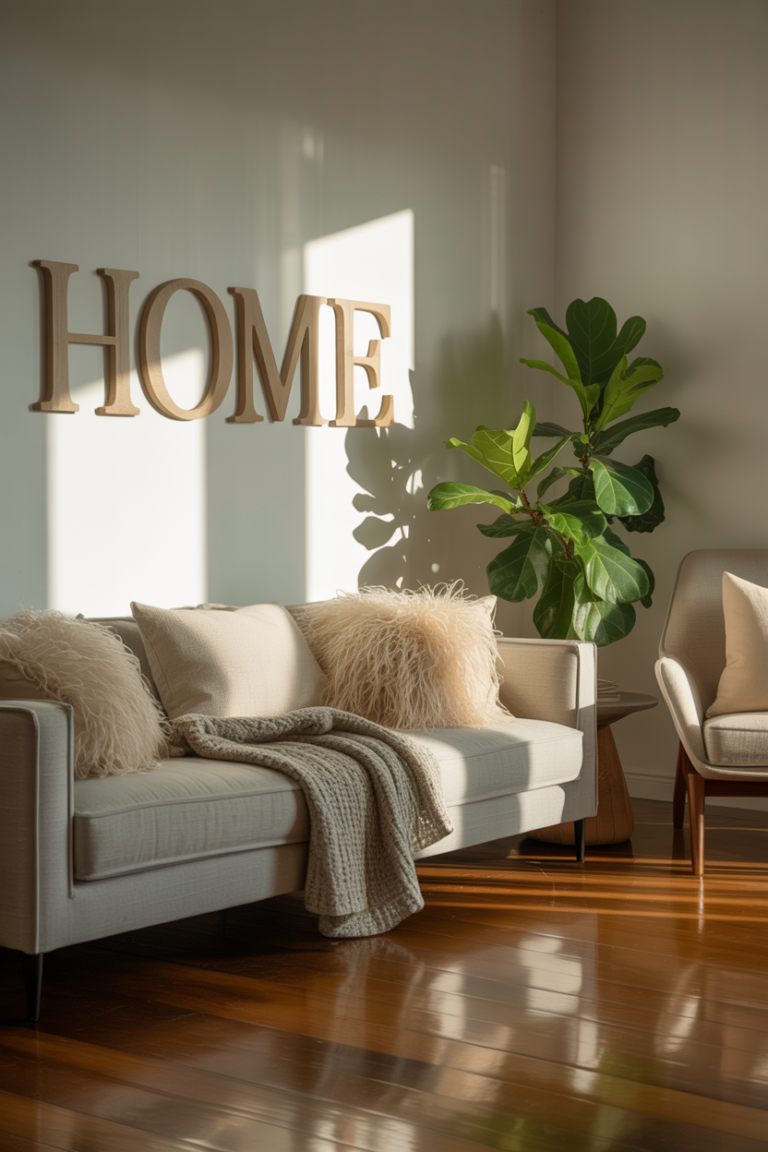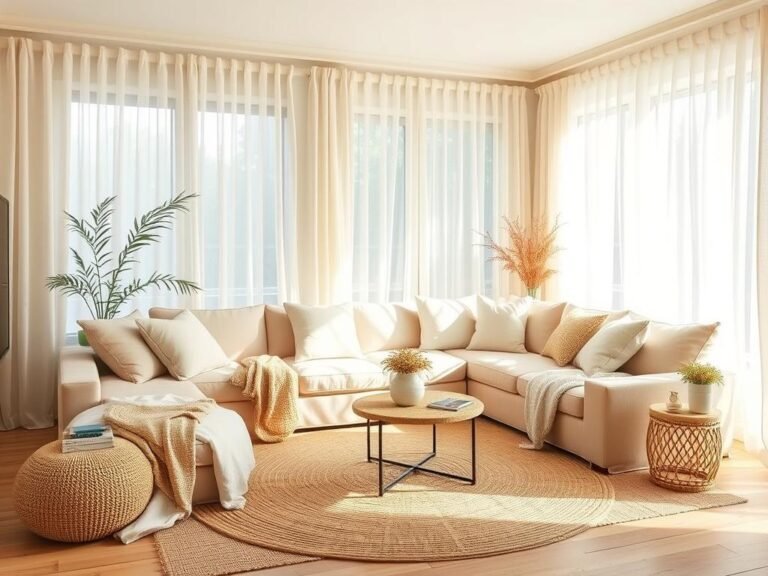Learn How to Design a Living Room Around Your Couch
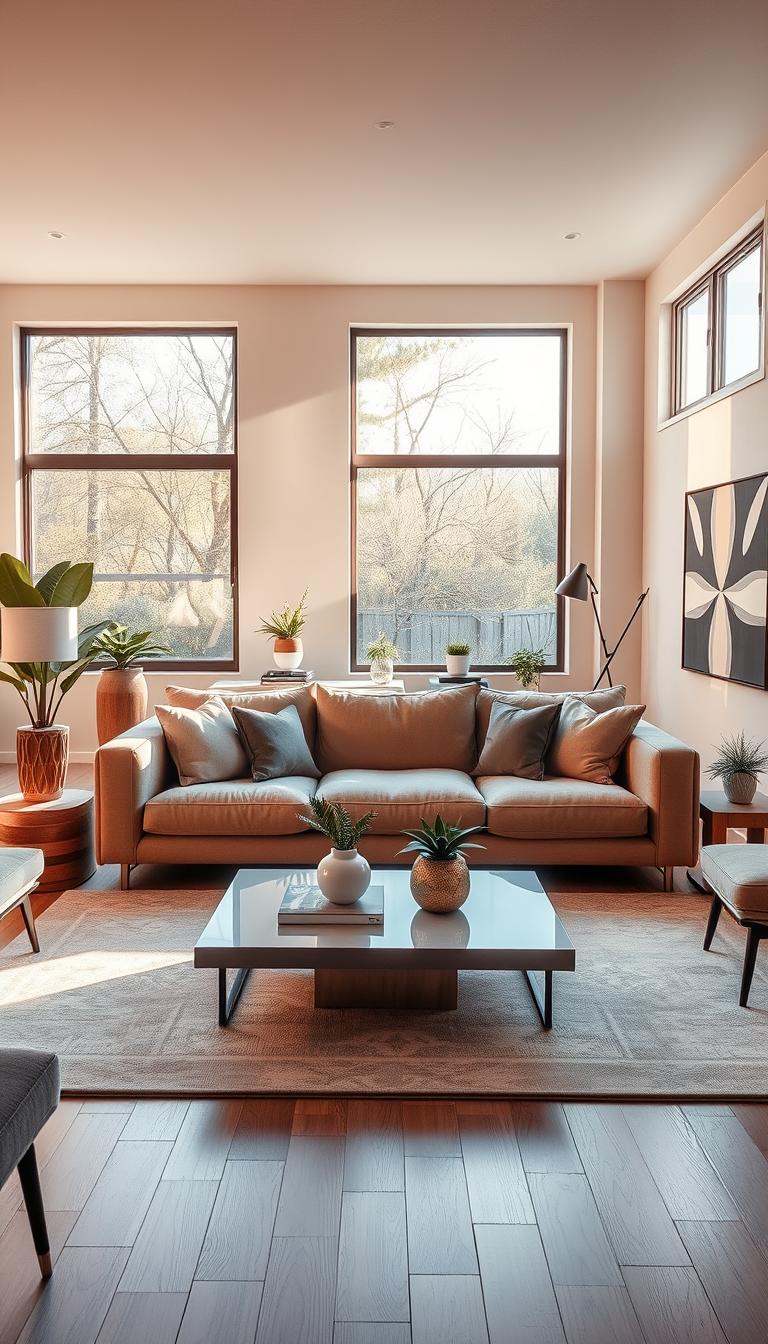
The average American spends over 1,460 hours yearly in their living room – often anchored by the couch. Yet 68% of homeowners feel their space doesn’t truly reflect their lifestyle. Why? Competing priorities like TV placement, fireplace sightlines, and natural light create a tug-of-war for attention.
Your sofa isn’t just furniture – it’s the heartbeat of shared moments. From movie nights to quiet mornings, its position shapes conversations, comfort, and even how sunlight dances across your floors. But balancing practicality with personality requires more than pushing furniture against walls.
Consider this: A well-planned layout solves three common struggles. It honors your room’s architectural features while keeping foot traffic smooth. It turns awkward corners into cozy reading nooks. Most importantly, it lets your couch become both a statement piece and a functional hub.
Key Takeaways
- Your couch anchors 83% of daily living room activities
- Fireplaces and windows often clash with TV placement
- Multi-use spaces demand flexible furniture arrangements
- Traffic flow impacts both safety and social dynamics
- Proportional spacing prevents cramped or empty zones
Introduction: Setting the Stage for Your Living Room Design
Your living room tells a story – one shaped by late-night conversations, weekend relaxation, and the rhythm of daily life. Before selecting room furniture or paint colors, pause to ask: What narrative do I want this space to convey? Authentic design begins with self-reflection, not Pinterest boards.
Understanding Your Space and Lifestyle
Measure twice, decorate once. Start by mapping your room’s dimensions and natural pathways. A family of five needs different flow than empty nesters – 48% of homeowners regret layouts that ignore their actual habits. Consider:
- Do you host game nights or prefer solo reading?
- Is the room a thoroughfare to other areas?
- Which architectural features demand attention?
Defining Your Personal Style
Style isn’t about trends – it’s about resonance. That mid-century sofa or vintage rug should spark joy, not just fill space. Interior designer Emily Henderson notes: “Rooms feel ‘right’ when pieces connect to your history or aspirations.” Try this exercise:
- Collect images of spaces that energize you
- Identify recurring colors/textures
- Edit ruthlessly – keep only what sings
Your couch becomes more than seating when surrounded by intentional choices. Blend textures like linen and wood for warmth, or add bold art that sparks conversation. The goal? A room that feels unmistakably yours.
Assessing Your Living Room’s Layout and Functions
Every room whispers clues about how it wants to be used. Start by sketching your floor plan – even roughly – to reveal hidden opportunities. Studies show 62% of seating areas function better when aligned with natural pathways, according to University of Arkansas research on spatial dynamics.
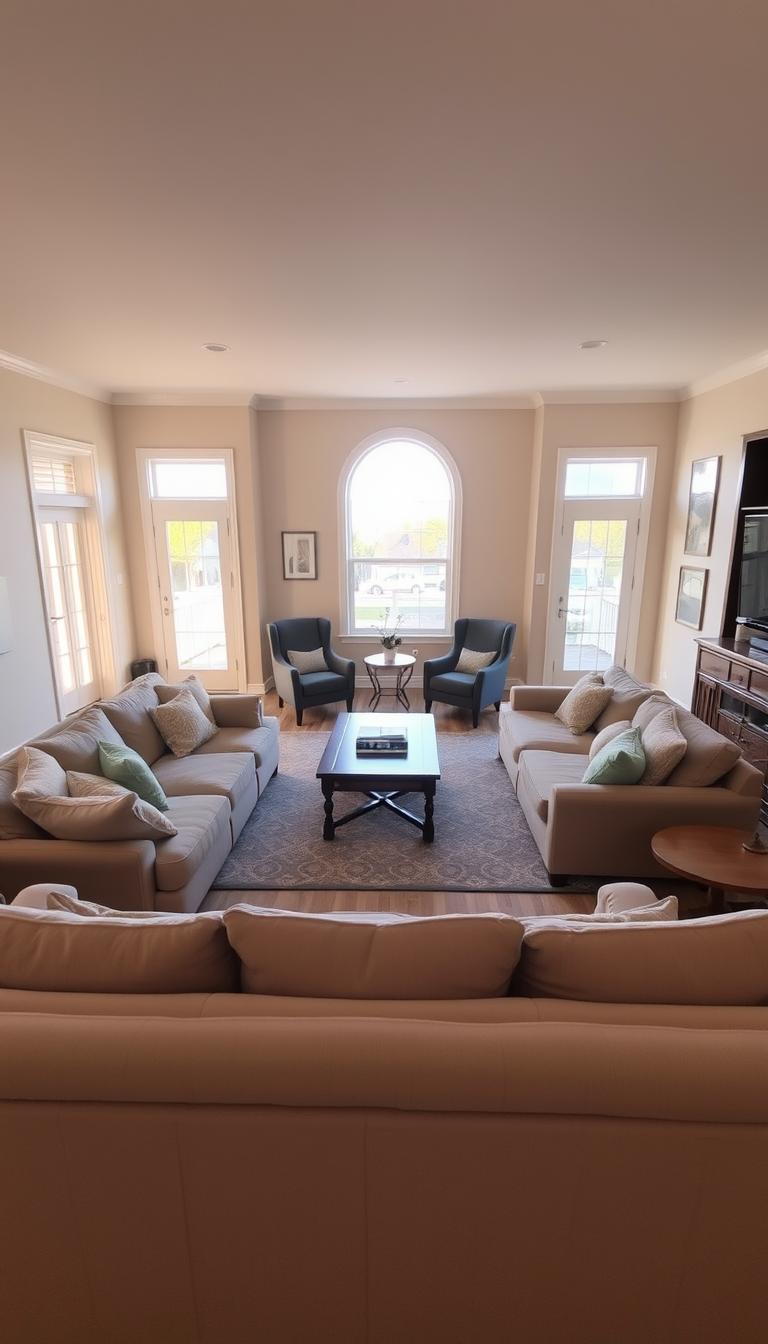
Identifying Key Zones and Traffic Flow
Divide your space into three core zones: connection (for conversation), circulation (for movement), and contemplation (for solo activities). A sofa facing two armchairs creates an instant social hub, while leaving 30-inch walkways prevents bottlenecks during gatherings. Interior designer Nate Berkus advises: “Furniture should lean into the room’s rhythm, not fight it.”
Try this exercise: Walk through your room at different times. Notice where feet naturally pause or pivot. These patterns highlight where your sofa can anchor the space without obstructing flow. A floating layout – where seating isn’t pushed against walls – often improves both aesthetics and accessibility.
Key considerations for harmony:
- Allow 18-24 inches between coffee tables and seating
- Keep primary pathways clear of side tables
- Use area rugs to define zones without physical barriers
When zones overlap gracefully, your furniture serves multiple purposes. A window-side chaise becomes both reading nook and guest seating. The result? A space that adapts to life’s changing currents while maintaining its core comfort.
How to Design a Living Room Around Your Couch: Key Principles
Your couch holds more influence than you might realize—it’s the compass guiding every design decision. Like a stage director positioning actors, its placement determines sightlines, energy flow, and functional harmony. Interior designer Kelly Wearstler observes: “Great rooms reveal hierarchy. When you let one piece lead, others fall into poetic alignment.”

Emphasizing the Couch as the Centerpiece
Start by floating your sofa 12-18 inches from walls. This creates breathing room while maintaining connection to windows or architectural features. Position side tables within arm’s reach but avoid overcrowding—42-inch walkways prevent that “obstacle course” feeling during gatherings.
Balance emerges through calculated asymmetry. Pair your couch with mismatched chairs that share a common material or color tone. A low-slung coffee table anchors the seating area without blocking sightlines to artwork or fireplaces. Design firm Studio McGee often uses this approach to blend modern minimalism with lived-in comfort.
Consider these spatial relationships:
- Allow 14-18 inches between sofa arms and adjacent furniture
- Angle reading lamps toward the couch’s central cushions
- Use console tables behind seating to define zones subtly
Natural light plays a supporting role. When windows flank your couch, layer sheer curtains to soften glare while maintaining outdoor views. This layout technique transforms your sofa into a sunlit sanctuary for morning coffee or evening relaxation.
Identifying Your Living Room’s Focal Point
What captures attention first when you enter a room? Your answer reveals the natural focal point – the element that anchors all other design choices. Nearly 72% of rooms have inherent architectural features competing for prominence, requiring intentional hierarchy to avoid visual chaos.

Choosing Between Fireplace, TV, or Window Views
Fireplaces command attention with their vertical lines and warmth, but televisions often dominate modern lifestyles. Balance both by angling your couch at a 45-degree angle to enjoy both features. For rooms with stunning windows, position seating to frame – not block – the view. A study by Architectural Digest found window-focused layouts increase perceived space by 19%.
Creating Visual Interest with Art and Decor
When architectural features lack impact, craft your own focal point. A gallery wall above the couch or bold sculpture on a side table draws the eye upward. Interior designer Justina Blakeney recommends: “Layer textures and scales – pair large abstract art with smaller ceramic pieces on adjacent surfaces.”
Key strategies for cohesion:
- Limit competing colors – let one hue dominate your focal area
- Use chairs with clean lines near busy artwork
- Position table lamps to cast warm pools of light on key features
Remember: focal points work best when supported, not surrounded. Leave breathing room between your sofa and accent walls. This thoughtful restraint lets each element shine while maintaining overall harmony.
Selecting the Perfect Couch as the Centerpiece
Choosing the right sofa transforms more than your seating—it defines your room’s entire personality. Like finding the perfect pair of jeans, it requires balancing comfort, proportions, and character. Start by measuring doorways and staircases—84% of interior designers cite delivery surprises as top client frustrations.

Consider depth as much as length. A 40-inch seat depth suits lounging, while 36 inches works better for upright conversation. For small rooms, apartment-sized sofas under 78 inches prevent overcrowding. Tested favorites like the Burrow Nomad Modular adapt to odd corners, while mid-century designs anchor open-concept spaces.
Three non-negotiable factors:
- Style continuity: Match leather tones to wood finishes or metal accents
- Traffic flow: Leave 24-36 inches between sofa and coffee table
- Future flexibility: Slipcovered pieces refresh easily; tight-back cushions maintain structure
Proportional harmony matters most. Divide your room’s square footage by 1.5 for maximum couch length. Oversize sectionals overwhelm compact spaces, while petite loveseats vanish in rooms with high ceilings. Designer Athena Calderone advises: “Let your sofa whisper ‘welcome’ through its silhouette before guests even sit.”
Finally, balance boldness with restraint. A velvet emerald couch shines when paired with neutral wood pieces. For traditional spaces, rolled arms and bun feet echo classic millwork. Modern rooms thrive with track arms and tapered legs. When size ratios align and accent pieces complement rather than compete, rooms feel cohesive yet captivating.
Arranging Surrounding Seating for Optimal Conversation
Conversation thrives when seating invites connection without crowding. The magic lies in creating intimate sightlines – chairs angled toward each other, love seats positioned at welcoming distances. Designers like Bobby Berk often use a simple test: “Can two people chat comfortably without leaning forward?”
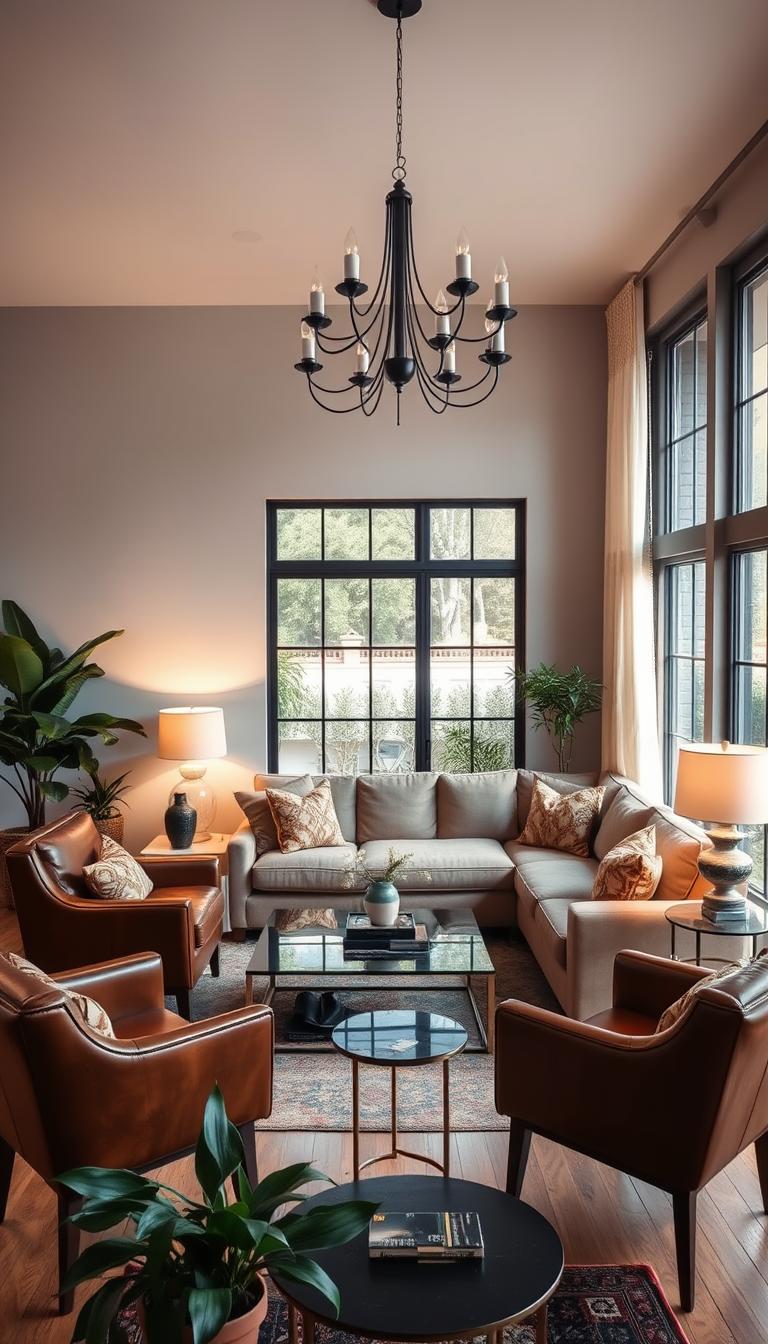
Harmony Through Strategic Placement
Symmetrical layouts bring order to busy spaces. Try flanking your sofa with identical armchairs, spaced 7-8 feet apart. This classic approach works well for formal areas. Floating arrangements offer modern flexibility – think swivel chairs that rotate toward different conversation groups.
Real-world solutions from design studios:
- Pair a 3-seater sofa with two barrel chairs at 45-degree angles
- Create U-shaped groupings for book club-style discussions
- Use nesting tables between seats for shared surface space
Blend styles to avoid stiffness. A tufted Chesterfield sofa feels approachable when paired with linen slipper chairs. Leave 18 inches between furniture edges – enough space for movement, close enough for passing snacks. As designer Amber Lewis notes: “Your seating should whisper ‘Stay awhile’, not shout ‘Don’t touch anything!’“
For impromptu gatherings, position ottomans near main seating. They triple as footrests, extra seats, or makeshift tables. This thoughtful approach transforms your space into a natural hub for connection.
Balancing Room Furniture and Accessories
A well-curated space feels like a symphony—each piece plays its part without overpowering the others. Blending furniture sizes and styles requires both intuition and strategy. Start by anchoring your living room layout with one statement piece, then layer complementary items that enhance without competing.

Mixing Different Furniture Sizes and Pieces
Scale creates rhythm. Pair your largest item—like a sectional—with mid-sized armchairs and a slender console table. This tiered approach adds depth while maintaining proportion. Interior designer Max Humphrey suggests: “Let your sofa claim 60% of visual weight, then distribute the remaining 40% across secondary pieces.”
Practical blending techniques:
- Use a 2:3 ratio between coffee tables and seating areas
- Flank tall bookshelves with low-profile ottomans
- Offset angular furniture with round side tables
Utilizing Accent Pieces for a Cohesive Look
Accessories act as punctuation marks. A bold ceramic vase atop a side table draws the eye upward, while woven baskets under consoles add texture. Limit decorative items to odd-numbered groupings—three varied-height candles or five stacked art books create rhythm without clutter.
Successful integrations balance color and form:
- Repeat your sofa’s accent hue in throw pillows and artwork
- Choose trays and bowls that echo metal finishes from lamps
- Place greenery near angular furniture to soften lines
Remember: Negative space matters. Leave 20% of surfaces bare to let your living room furniture breathe. This restraint transforms collections into curated moments rather than crowded displays.
Creating Flow with Effective Traffic Paths
Movement shapes how we experience a room—like rivers carving paths through landscapes. Clear walkways prevent that “should I walk here?” hesitation during gatherings. Start by mapping primary routes between doorways and seating clusters. A 36-inch main pathway allows two people to pass comfortably, while 24-inch gaps around furniture keep movement fluid.

Strategic spacing solves common frustrations. Leave 18 inches between your coffee table and sofa for easy access to drinks or books. Side tables should sit within arm’s reach—but never block natural walkways. Interior designer Nate Berkus reminds us: “Rooms feel inviting when they respect both stillness and motion.”
- Maintain 30 inches behind chairs for seated guests to rise easily
- Keep 42 inches between opposing furniture pieces for visual balance
- Angle armchairs slightly toward the room’s natural entry points
Your room layout thrives on intentional pauses. Position the coffee table as a central anchor, but make sure it doesn’t disrupt primary routes. For open-concept spaces, use area rugs to subtly guide foot traffic around conversation zones. Test your plan by walking through common scenarios—carrying a tray of snacks or retrieving a book from shelves.
Successful flow feels instinctive. When furniture placement honors both human movement and quiet moments, your space becomes effortlessly functional. That’s the quiet magic of thoughtful design—it supports life without demanding attention.
Incorporating Area Rugs to Unify Your Space
A rug anchors more than feet—it weaves together colors, textures, and furniture into a harmonious composition. Studies show properly scaled rugs make rooms feel 23% more intentional, according to spatial design research from Parsons School of Design. This foundation layer quietly reinforces your focal point while softening acoustics and footfalls.

Choosing the Right Rug Size and Placement
Size determines impact. For a seating area, ensure all front legs of sofas and chairs rest on the rug. This creates visual unity without swallowing the space. In open layouts, extend rugs 18-24 inches beyond furniture edges to define zones clearly.
Consider these guidelines from interior experts:
- 8×10-foot rugs suit most standard conversation groupings
- Round shapes soften angular furniture arrangements
- Low-pile options ease chair movement in high-traffic areas
When arranging furniture, let the rug’s pattern guide your layout. Stripes can elongate narrow rooms, while concentric circles draw eyes toward your focal point. In one Manhattan apartment, a vintage Persian rug transformed disjointed pieces into a cohesive lounge area simply by aligning its medallion with the fireplace.
Balance texture with neighboring elements. A chunky wool rug complements sleek leather sofas, while flatweaves let ornate coffee tables shine. Remember: your rug shouldn’t compete for attention—it should quietly orchestrate the room’s rhythm.
Lighting, Artwork, and Decorative Details
Light transforms rooms like a painter’s brush—subtle strokes define mood and dimension. The right balance between shadow and illumination elevates your space from functional to felt. Start by considering three light sources: ambient (overhead), task (reading lamps), and accent (wall sconces).
Layering Lighting with Purpose
Floor lamps work best 3 feet from seating areas—a 3-foot rule ensures glare-free comfort. Table lamps with adjustable arms let you direct light where needed most. For art displays, use picture lights angled at 30 degrees to minimize reflections.
In a Brooklyn brownstone, designers paired a sculptural floor lamp with linen drum shades. This combo softened the room feel while maintaining brightness for evening gatherings. Remember: dimmer switches add flexibility, letting you shift from brunch casual to dinner party elegance.
Curating Visual Harmony
Art should command attention without overwhelming. Apply the 2/3 rule: artwork width equals two-thirds of your sofa’s length. Mirrors opposite windows amplify natural light, making small spaces feel airier. A San Francisco loft used an oversized abstract painting above the couch, flanked by circular mirrors that doubled the room’s perceived depth.
Final touches matter most. Cluster votives on side tables for warm pools of light. Position plants near lamps to cast intriguing leaf shadows. These details stitch together your room feel, creating spaces that resonate long after you flip the switch.
Maximizing Storage and Functionality
Smart storage solutions act as silent partners in great design – they organize chaos while enhancing aesthetics. The secret lies in blending practicality with visual appeal, creating spaces that feel both lived-in and intentional.
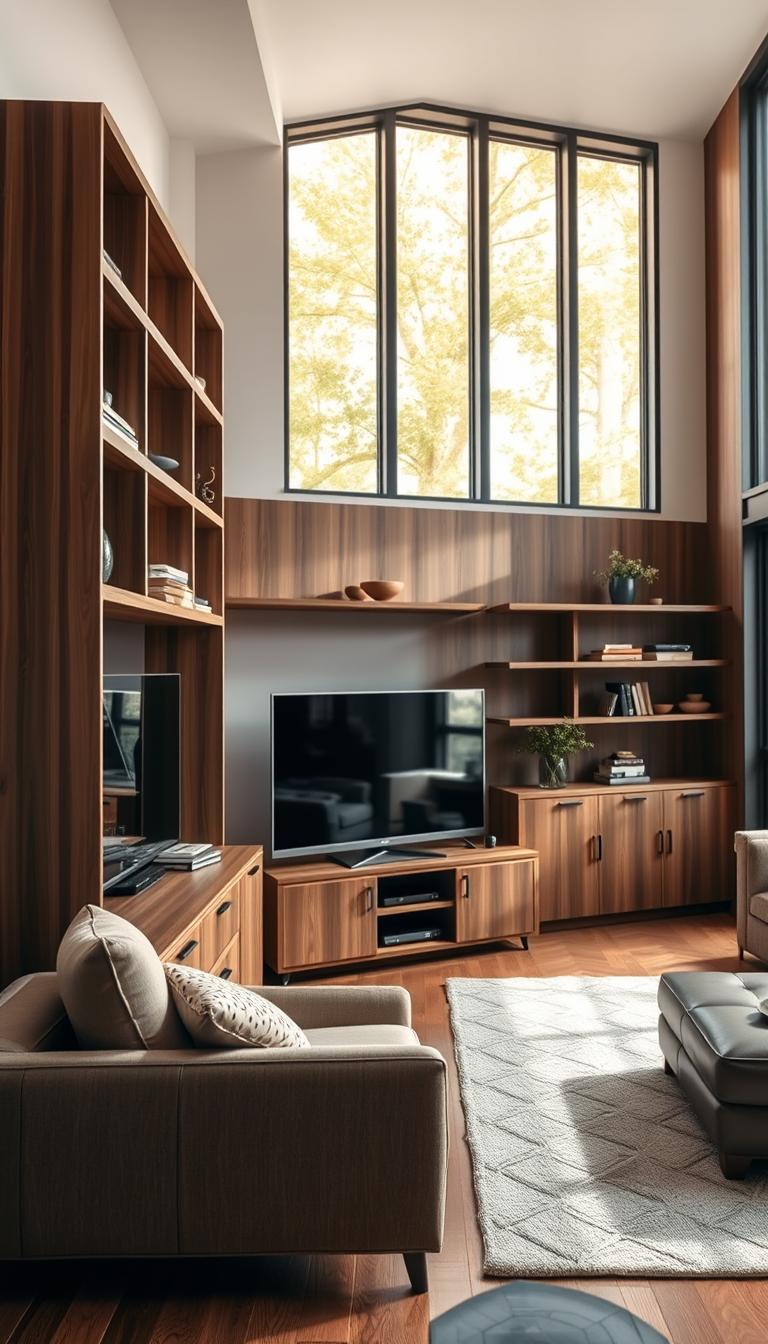
Integrating Clever Storage Solutions
Built-in cabinets flanking a fireplace offer symmetry while hiding board games or media equipment. Choose recessed units with glass-front upper cabinets to display curated objects, keeping the area feeling open. Multipurpose ottomans with lift-up lids provide hidden storage without sacrificing seating flexibility.
Consider these strategic approaches:
- Floating shelves above seating groups reduce visual weight
- Nesting tables tuck neatly beside sofas when not in use
- Baskets woven from natural fibers conceal throws yet add texture
Near high-traffic zones, a slim console table behind your sofa maintains flow while offering surface space. Top it with trays for corralling remotes or small plants. Designers often use this technique to create transitional storage that feels purposeful rather than cluttered.
Remember: functional spaces adapt to your rhythm. When storage solutions mirror daily habits – like shallow drawers for charging cables – they become invisible helpers. This thoughtful integration lets your room breathe while keeping essentials within arm’s reach.
Dealing with Irregular Room Shapes and Sizes
Unconventional spaces hold unexpected potential—their quirks become opportunities when approached creatively. Instead of fighting angles or awkward proportions, lean into what makes your room unique. A thoughtful arrangement transforms limitations into character-defining features.
Tips for Narrow, L-Shaped, and Open-Concept Rooms
Narrow rooms thrive with floating furniture perpendicular to the longest wall. Place your sofa facing inward, creating intimate conversation pockets. In L-shaped layouts, anchor each “leg” with distinct zones: a reading nook in one corner, a media area in the other. For open-concept spaces, position a console table behind seating to subtly demarcate areas without walls.
Consider a Brooklyn loft where an L-shaped sectional hugged two walls, leaving space for a circular coffee table at the bend. This smart arrangement created natural flow between dining and lounging areas. Flexible pieces like ottomans on casters adapt to impromptu gatherings or solo relaxation.
Creating Zones with Rugs and Furniture Groupings
Rugs act as visual anchors. Layer a jute base rug under a smaller patterned one to define seating clusters. Angle armchairs slightly toward your sofa—even 15 degrees fosters easier conversation. In one Seattle home, a 9×12 rug united mismatched chairs and a loveseat into a cohesive arrangement beneath sloped ceilings.
- Use oval coffee tables to soften sharp room angles
- Float shelves between zones as functional art displays
- Place floor lamps at zone edges to softly delineate spaces
Remember: irregular rooms reward experimentation. Try three different layouts over a weekend—you’ll discover surprising ways to celebrate your space’s distinctive rhythm.
Optimizing TV Placement within the Room
Your television serves dual roles – entertainment hub and design element. Strategic placement enhances both function and form, creating spaces where technology complements rather than dominates. Let’s explore principles that honor your room’s flow while ensuring screen-time comfort.
Positioning Your Television for Comfortable Viewing
Start by assessing sightlines from primary seating. The ideal viewing angle keeps eyes level with the screen’s center – typically 42 inches from the floor. This prevents neck strain while maintaining a natural gaze direction during movie nights or sports events.
Avoid placing screens directly opposite windows to minimize glare. If unavoidable, install blackout curtains or use matte anti-reflective screen protectors. Designers at Room & Board recommend angling TVs 15-20 degrees away from light sources for optimal clarity.
Three placement strategies balance aesthetics and practicality:
- Mount screens 7-12 feet from front row seating (based on screen size)
- Center TVs on the wall they occupy, flanked by balanced decor
- Use low-profile consoles to ground the screen without visual heaviness
Experiment with temporary setups before committing. Place your TV on a movable stand for a week, testing different locations during day and evening use. Notice how light shifts affect visibility and how the screen’s presence impacts room harmony.
Remember: The best way to integrate technology honors both your viewing habits and design vision. When screens feel like natural extensions of your space rather than intrusions, entertainment becomes effortless.
Tips for Small Living Room Layouts
Small living rooms demand big creativity. By embracing vertical space and prioritizing function, compact areas can feel airy and intentional. Start by measuring your floor plan – even a 12×12 room holds potential when arranged thoughtfully.
Using Low Furniture and Strategic Arrangements
Low-profile sofas sitting 15-18 inches off the floor create visual height. Pair with leggy accent chairs to maintain sightlines across the room. Leave 24 inches between seating and walls – this breathing room prevents a boxed-in feel.
Try angling furniture toward a focal point like a window or artwork. A loveseat placed diagonally in a corner opens walkways while framing the space. Designers at Mix & Match Design often use this technique to maximize square footage.
Maximizing Space with Multifunctional Pieces
Ottomans with hidden storage triple as footrests, tables, and toy bins. Choose nesting side tables that tuck neatly under consoles when not in use. A 36-inch wide bench beneath windows serves as both seating and display surface.
Three space-enhancing strategies:
- Mount floating shelves 18 inches above seating for books/decor
- Use mirrors to reflect light from your focal point
- Opt for armless chairs that slide completely under tables
Remember: Every inch counts. A slim console behind your sofa adds surface space without eating into walkways. When furniture serves multiple roles, your room adapts effortlessly to daily life’s changing rhythms.
Embracing Flexibility for Future Redesigns
Life evolves—and so should your living space. The most enduring rooms adapt to shifting priorities, whether welcoming new family members or accommodating evolving hobbies. Building flexibility into your design lets spaces grow with you, not against you.
Adapting Your Layout to Changing Needs
Modular sofas with detachable sections let you create new seating configurations as needs change. Pair them with lightweight accent chairs that can shift from reading corners to conversation clusters. A study by Home & Design Magazine found households using adaptable furniture report 31% higher long-term satisfaction.
Three strategies for fluid spaces:
- Anchor with neutrals: Choose a timeless sofa color, then refresh through pillows and throws
- Embrace mobility: Use ottomans instead of fixed coffee tables for impromptu seating
- Layer lighting: Plug-in sconces adjust easier than hardwired fixtures
Consider a Boston family who reconfigured their L-shaped sectional annually—first as a playpen barrier, later as a teen hangout zone. Their secret? Leaving 18 inches between furniture and walls for easy adjustments. This approach honors life’s seasons without requiring full renovations.
True flexibility isn’t about constant change—it’s creating spaces that welcome transformation. When your sofa becomes a starting point rather than a fixed destination, rooms stay relevant through every chapter.
Conclusion
Creating harmony between comfort and style transforms more than your space—it shapes daily experiences. Your couch anchors this balance, serving as both functional foundation and emotional touchstone. Remember to center arrangements around its proportions while leaving room for art and decor that spark joy.
Effective layouts flow naturally when you prioritize three elements: focal points that draw the eye, layered lighting for mood shifts, and smart storage that keeps surfaces clear. These principles work back-to-back with your lifestyle, whether hosting gatherings or enjoying quiet evenings.
Odd-shaped rooms needn’t limit creativity. Floating furniture arrangements and multi-height decor adapt to any footprint. Trust the art of intentional design—a well-placed mirror or textured throw often achieves what costly renovations cannot.
As you refine your space, fall back on timeless principles rather than fleeting trends. Let your couch’s placement encourage connection, your lighting choices enhance ambiance, and your personal artifacts tell your story. Small adjustments ripple outward, turning houses into homes that breathe with purpose.
Your living area awaits its next chapter. What subtle change will you make today to elevate the art of everyday living?
